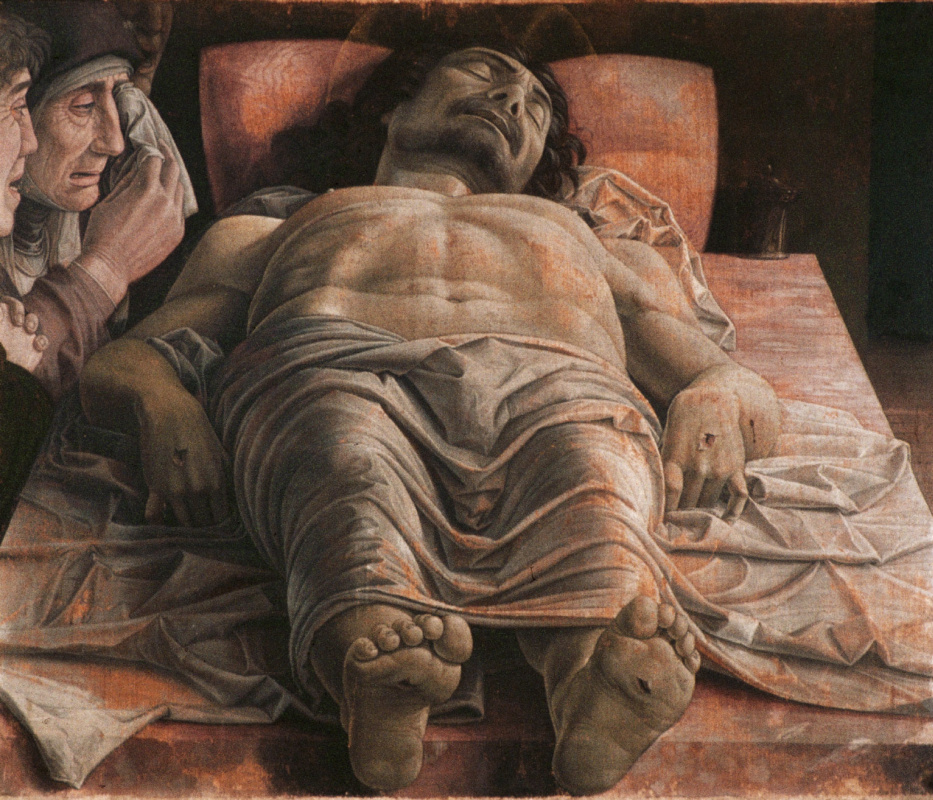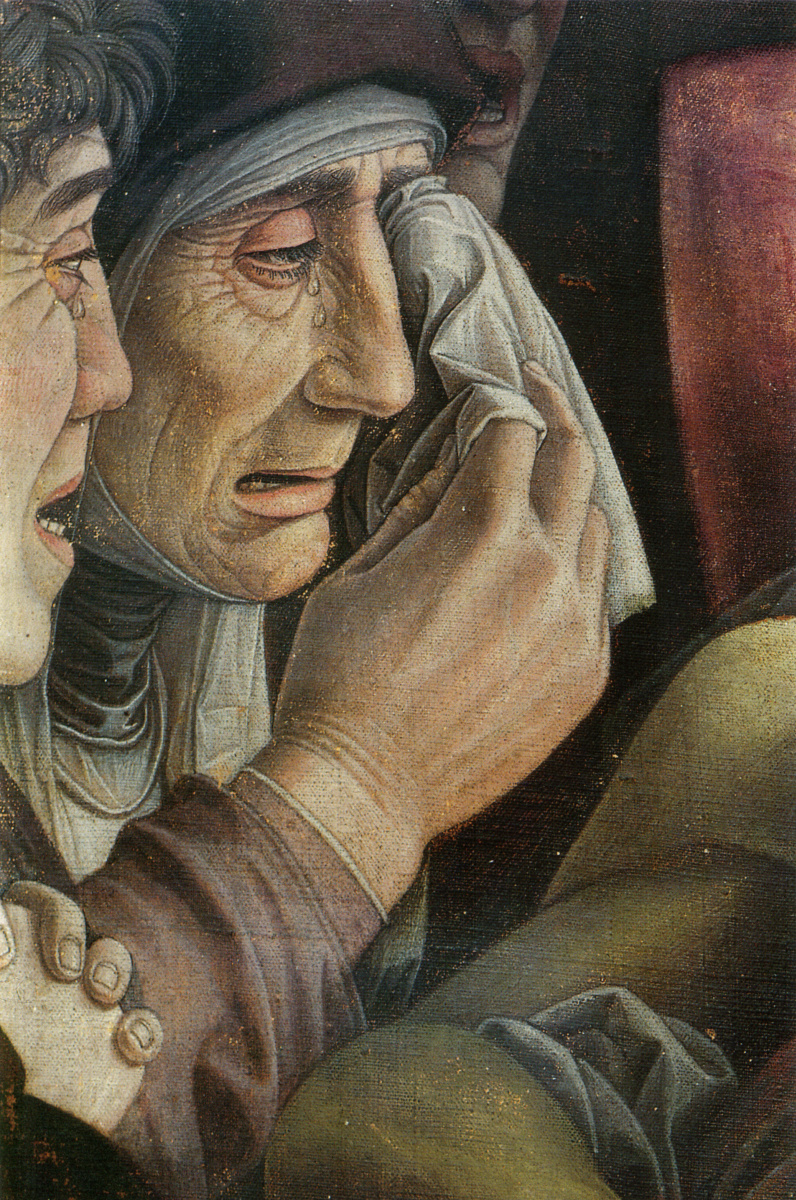log in
Enter site
Login to use Arthive functionality to the maximum
Dead Christ (Mourning the Dead Christ)
Andrea Mantegna • Painting, 1483, 81×66 cm
Description of the artwork «Dead Christ (Mourning the Dead Christ)»
Stored in Brera's Milan Pinacoteca Mourning the Dead Christ - not only the most famous painting by Andrea Mantegna, but also one of the most unusual in world painting.
What is its unusual?
Firstly, in the composition. Christ's heels touch the lower edge of the picture, and the head almost rests on the upper. In such a placement of the body on the canvas there would be nothing special if it were a frontally located figure - standing or sitting. Another thing is to depict a lying body perpendicular to the horizontal axis. Mantegna had to resort to an extremely sharp perspective reduction and choose a very low point of view. And he did it with masterly credibility: here his studious studies treatises on perspective, geometry and optics.
Secondly, the unusual “Mourning of the Dead Christ” Mantegna in naturalism. Contrary to his reverence for antiquity with its cult of heroes and ideal handsome men, the Savior Mantegna portrays a deliberate commoner. This is evidenced by his angular face, broad peasant chest, hardened, stressed feet. Similarly, Virgin Mary in the picture “Madonna and Child, John the Baptist and Mary Magdalena” endowed with a pretty, but pockmarked and dazzled face of a peasant woman. Even clearer is this trend in the picture "Christ Carrying the Cross".
Obviously, this stubborn reluctance to aristocratize the "King of the Jews" was the principal position of the artist. Thus, Andrea, the son of a Padua lumberjack, brings Jesus, the son of a Bethlehem carpenter, closer to the wise and poor - to whom, in fact, Christ (at the time of Mantegna was finally monopolized by the Vatican) came.
Passion for “Mourning the Dead Christ”
It is known that this painting was very expensive Mantegnier and was stored in his house until the death of the artist. It is assumed that the only “Mourning of the Dead Christ” that has survived to this day is the original copy, and the original has been lost.
Already today, real battles for the picture have unfolded between Milan and Mantua. In 2006, when the 500th anniversary of the artist’s death was celebrated, the center of the festivities was to be Mantova, where Mantegna worked and lived most of his life and where he was buried. However, the Pinacoteca Brera in Milan refused to provide “Mourning the Dead Christ” for the Mantua exhibition. A major scandal arose, which the then Minister of Culture of Italy Francesco Rutelli was forced to solve. As a result, Milanese experts were able to prove that the tempera on Mantegna's canvas is too fragile and will not survive transportation even to nearby Mantua. However, it cannot be ruled out that the issue here is not the preservation of the masterpiece, but the notorious cultural rivalry of the northern Italian cities.
Visual quote from Mantegna in the film by Andrei Zvyagintsev
The picture continues to excite the minds now.
For example, in the 10th minute of Andrei Zvyagintsev’s film “Return” we can see direct quotation "Mourning the dead Christ". For the first time, teenage sons see a sleeping father suddenly appearing out of nowhere in their lives. He lies on the bed in the same position and is taken from the same low angle in which Christ Mantegna is written. Zvyagintsev sets up a parable film, and with this unambiguous quote, he obviously fixes the parallel between father and God: both are harsh and adamant, both interfere in a person’s life when they are least expected, both dictate their will to their sons and are both incomprehensible.
Author: Anna Yesterday
What is its unusual?
Firstly, in the composition. Christ's heels touch the lower edge of the picture, and the head almost rests on the upper. In such a placement of the body on the canvas there would be nothing special if it were a frontally located figure - standing or sitting. Another thing is to depict a lying body perpendicular to the horizontal axis. Mantegna had to resort to an extremely sharp perspective reduction and choose a very low point of view. And he did it with masterly credibility: here his studious studies treatises on perspective, geometry and optics.
Secondly, the unusual “Mourning of the Dead Christ” Mantegna in naturalism. Contrary to his reverence for antiquity with its cult of heroes and ideal handsome men, the Savior Mantegna portrays a deliberate commoner. This is evidenced by his angular face, broad peasant chest, hardened, stressed feet. Similarly, Virgin Mary in the picture “Madonna and Child, John the Baptist and Mary Magdalena” endowed with a pretty, but pockmarked and dazzled face of a peasant woman. Even clearer is this trend in the picture "Christ Carrying the Cross".
Obviously, this stubborn reluctance to aristocratize the "King of the Jews" was the principal position of the artist. Thus, Andrea, the son of a Padua lumberjack, brings Jesus, the son of a Bethlehem carpenter, closer to the wise and poor - to whom, in fact, Christ (at the time of Mantegna was finally monopolized by the Vatican) came.
Passion for “Mourning the Dead Christ”
It is known that this painting was very expensive Mantegnier and was stored in his house until the death of the artist. It is assumed that the only “Mourning of the Dead Christ” that has survived to this day is the original copy, and the original has been lost.
Already today, real battles for the picture have unfolded between Milan and Mantua. In 2006, when the 500th anniversary of the artist’s death was celebrated, the center of the festivities was to be Mantova, where Mantegna worked and lived most of his life and where he was buried. However, the Pinacoteca Brera in Milan refused to provide “Mourning the Dead Christ” for the Mantua exhibition. A major scandal arose, which the then Minister of Culture of Italy Francesco Rutelli was forced to solve. As a result, Milanese experts were able to prove that the tempera on Mantegna's canvas is too fragile and will not survive transportation even to nearby Mantua. However, it cannot be ruled out that the issue here is not the preservation of the masterpiece, but the notorious cultural rivalry of the northern Italian cities.
Visual quote from Mantegna in the film by Andrei Zvyagintsev
The picture continues to excite the minds now.
For example, in the 10th minute of Andrei Zvyagintsev’s film “Return” we can see direct quotation "Mourning the dead Christ". For the first time, teenage sons see a sleeping father suddenly appearing out of nowhere in their lives. He lies on the bed in the same position and is taken from the same low angle in which Christ Mantegna is written. Zvyagintsev sets up a parable film, and with this unambiguous quote, he obviously fixes the parallel between father and God: both are harsh and adamant, both interfere in a person’s life when they are least expected, both dictate their will to their sons and are both incomprehensible.
Author: Anna Yesterday



